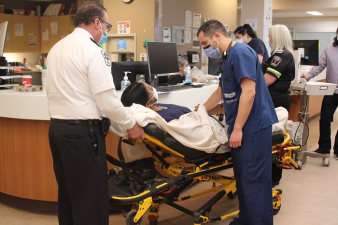
What Are the Emergency Stroke Treatment Protocols?
When a stroke occurs, every second counts. Immediate medical intervention is crucial for minimizing brain damage and improving outcomes. Emergency stroke treatment protocols typically include the following steps:
1. Recognizing the Symptoms: Early recognition of stroke symptoms is vital. Common signs include sudden numbness or weakness, especially on one side of the body, confusion, trouble speaking, vision problems, and difficulty walking. The "FAST" acronym (Face drooping, Arm weakness, Speech difficulty, Time to call 911) is a helpful guide.
2. Triage and Rapid Response: Upon arrival at the hospital, the medical team will quickly assess the type of stroke (ischemic or hemorrhagic) to determine the appropriate treatment. Time-sensitive treatment, such as the administration of tissue plasminogen activator (tPA) for ischemic strokes, can significantly reduce the damage caused by the stroke.
3. Imaging and Diagnostics: The use of CT scans and MRIs helps doctors identify the location and size of the stroke and decide on the best course of action. For ischemic strokes, the goal is to restore blood flow to the brain as quickly as possible.
4. Medication and Surgery: Emergency protocols may include intravenous tPA (for ischemic strokes) to dissolve blood clots. In some cases, mechanical thrombectomy, a procedure to remove clots from the brain, is performed. Hemorrhagic strokes may require surgery to repair damaged blood vessels.
The faster the intervention, the better the chances of a full recovery.
What Are the Acute Ischemic Stroke Treatment Options?
Acute ischemic stroke occurs when a blood clot blocks a blood vessel in the brain, cutting off the brain’s oxygen supply. Treatment options for acute ischemic stroke are designed to restore blood flow and minimize brain damage:
1. Thrombolysis (tPA): Tissue plasminogen activator (tPA) is the most commonly used medication to treat acute ischemic stroke. It helps dissolve the clot and restore blood flow. tPA must be administered within a few hours of stroke onset for the best results.
2. Mechanical Thrombectomy: For some patients, mechanical thrombectomy is used to physically remove large blood clots from the brain. This procedure is often performed in conjunction with tPA for faster and more effective treatment.
3. Antiplatelet and Anticoagulant Medications: Once the immediate threat is addressed, doctors may prescribe medications like aspirin or anticoagulants to prevent further clots from forming.
4. Endovascular Procedures: In certain cases, doctors may use specialized catheters to remove or break up the clot directly, restoring blood flow to the brain.
Acute ischemic stroke treatment is most effective when administered quickly, which is why recognizing the symptoms early and seeking emergency care is critical.
What Are the Stroke Rehabilitation Centers in the USA?
Stroke rehabilitation is essential for helping individuals recover lost abilities and regain independence after a stroke. There are many rehabilitation centers in the USA specializing in stroke recovery. These centers provide physical, occupational, and speech therapy to aid in the recovery process. Some of the leading stroke rehabilitation centers in the USA include:
1. Mayo Clinic (Minnesota): Known for its comprehensive stroke rehabilitation services, Mayo Clinic provides specialized care for stroke survivors, including advanced therapy programs.
2. Johns Hopkins Rehabilitation Network (Maryland): Johns Hopkins offers a multidisciplinary approach to stroke rehabilitation, combining physical therapy, occupational therapy, and speech therapy to help patients regain functional abilities.
3. Cleveland Clinic Rehabilitation (Ohio): Cleveland Clinic offers a range of services for stroke rehabilitation, including personalized care plans, rehabilitation therapies, and emotional support.
4. Rusk Rehabilitation at NYU Langone (New York): This renowned center provides comprehensive stroke rehabilitation, including therapies designed to help patients improve motor skills and regain speech and cognitive functions.
Finding a specialized stroke rehabilitation center is crucial for ensuring a thorough and effective recovery process.
What Is Post-Stroke Care and Management?
Post-stroke care is critical for minimizing the risk of further strokes and promoting recovery. After the initial treatment for stroke, patients need ongoing care and management to help them regain independence and prevent complications. Key elements of post-stroke care include:
1. Medication Management: Patients may be prescribed medications to manage risk factors such as high blood pressure, diabetes, and cholesterol. Anticoagulants or antiplatelet drugs may also be used to prevent further clots.
2. Physical Therapy: Physical therapy focuses on helping stroke survivors regain strength, balance, and coordination. This can involve exercises to improve motor skills and reduce the risk of falls.
3. Speech Therapy: Stroke survivors who have difficulty speaking or swallowing may benefit from speech therapy to help restore their communication skills and ability to eat safely.
4. Emotional and Psychological Support: Post-stroke depression and anxiety are common. Counseling and support groups can help patients and their families cope with the emotional challenges of recovery.
5. Lifestyle Modifications: Maintaining a healthy lifestyle through diet, exercise, and stress management is crucial for preventing future strokes and improving overall health.
Effective post-stroke care is essential for maximizing recovery and improving quality of life.
What Are Stroke Prevention Strategies?
While stroke treatment is important, preventing a stroke from occurring in the first place is the best strategy. Here are some effective stroke prevention strategies:
1. Control High Blood Pressure: High blood pressure is the leading cause of stroke. Keeping blood pressure under control through medication, a healthy diet, and regular exercise is essential for preventing strokes.
2. Manage Diabetes: Diabetes increases the risk of stroke by damaging blood vessels. Properly managing blood sugar levels through diet, exercise, and medication can help reduce the risk.
3. Quit Smoking: Smoking damages blood vessels and increases the likelihood of clot formation. Quitting smoking can significantly reduce the risk of stroke.
4. Limit Alcohol Intake: Drinking excessive amounts of alcohol increases blood pressure and the risk of stroke. Moderating alcohol consumption can help reduce stroke risk.
5. Exercise Regularly: Regular physical activity helps improve cardiovascular health, maintain a healthy weight, and lower the risk of stroke.
6. Healthy Diet: A diet rich in fruits, vegetables, whole grains, and lean proteins, and low in saturated fats, can help prevent stroke.
By adopting these prevention strategies, individuals can significantly reduce their risk of having a stroke.
Conclusion
Stroke is a life-threatening medical condition that requires prompt treatment and ongoing management. Understanding emergency stroke treatment protocols, acute ischemic stroke treatment options, rehabilitation centers, post-stroke care, and stroke prevention strategies is essential for effective recovery and long-term health. By recognizing symptoms early, seeking immediate treatment, and following a comprehensive care plan, stroke survivors can achieve better outcomes and improve their quality of life.



